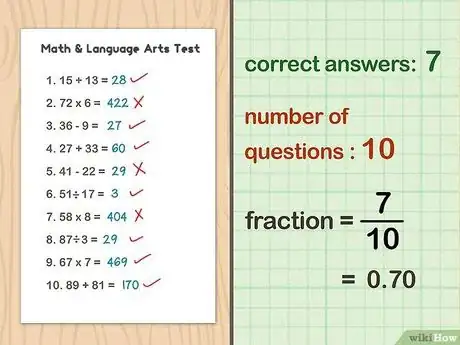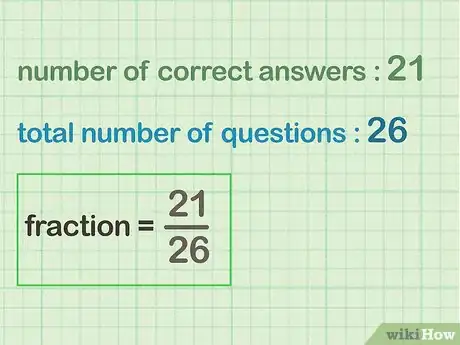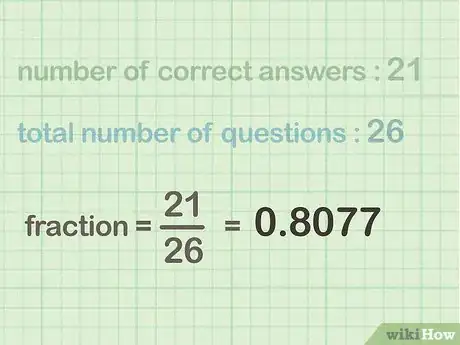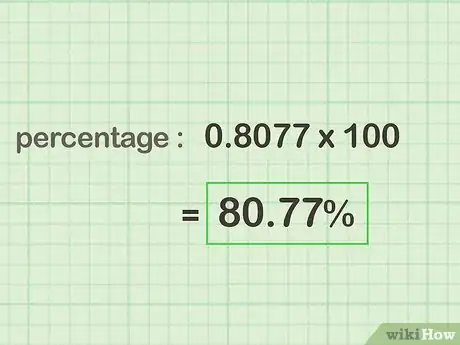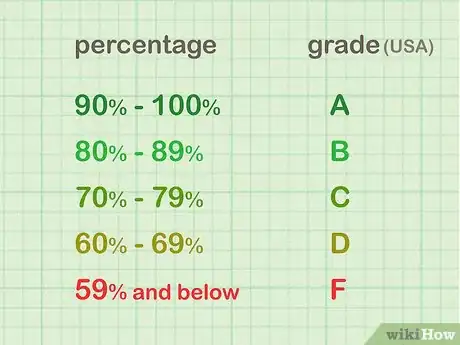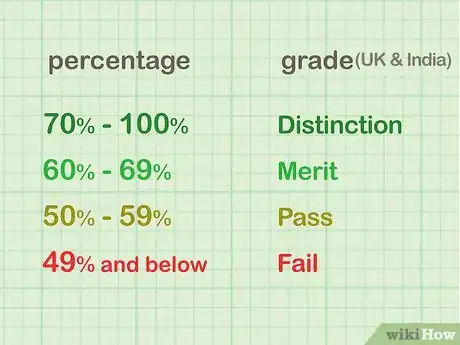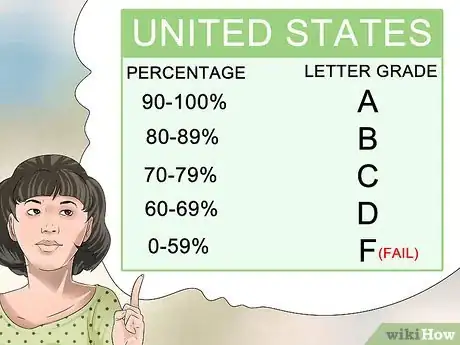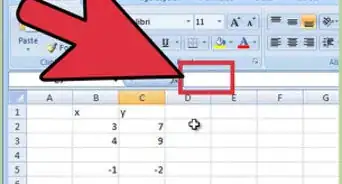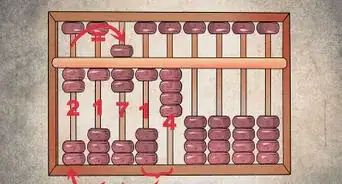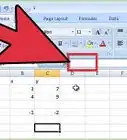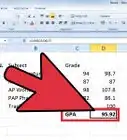This article was co-authored by David Jia. David Jia is an Academic Tutor and the Founder of LA Math Tutoring, a private tutoring company based in Los Angeles, California. With over 10 years of teaching experience, David works with students of all ages and grades in various subjects, as well as college admissions counseling and test preparation for the SAT, ACT, ISEE, and more. After attaining a perfect 800 math score and a 690 English score on the SAT, David was awarded the Dickinson Scholarship from the University of Miami, where he graduated with a Bachelor’s degree in Business Administration. Additionally, David has worked as an instructor for online videos for textbook companies such as Larson Texts, Big Ideas Learning, and Big Ideas Math.
This article has been viewed 2,463,575 times.
If your test score wasn't converted to a percentage or letter grade by your teacher, don't worry! You can easily calculate your test grade using a few simple steps.
Steps
Calculating Your Grade with a Simple Equation
-
1Count your correct answers. Figure out how many questions you answered correctly and write this number down. Then, draw a line under this number so that it is the top number of a fraction. For example, if you had 21 correct answers, write down 21/. Do not write anything under the fraction yet.
- For long tests, it might be easier to subtract the number of questions you got wrong from the total number of questions on the test. For example, if you got 5 questions wrong on a 26-question test, subtract 5 from 26 (26 - 5 = 21). Then, use 21 as the top number in your fraction.
- If some questions are worth more points than others, use the total number of points you earned as your top number instead. For example, if you earned 53 points out of 70 points possible, then write 53 as your top number.
-
2Write the total number of questions or points on the bottom of the fraction. Finish the fraction with the total number of questions or points on the test. In our example, if the test had 26 questions, then your fraction would be 21/26.
- Check your fraction to make sure that it is set up correctly. Remember that the number of questions you got right or the number of points you earned should be on the top of the fraction. The total number of questions on the test or the total number of points possible should be at the bottom of the fraction.
Advertisement -
3Use a calculator to divide the top number by the bottom number. You can use a basic calculator to figure out your percentage grade on the test. Just divide the top number by the bottom number. For example, take 21/26 and plug it into the calculator as 21 ÷ 26. You should get the answer 0.8077.[1]
- Don’t worry about the numbers past the first four digits of the answer. For example, if the answer was 0.8077777, then you can just ignore the last three sevens. They will not affect your percentage.
-
4Multiply your answer by 100 to get your percentage. You can do this with your calculator or just move the decimal point two digits to the right. The answer will be your grade as a percentage (your score out of 100). In our example, 0.8077 x 100 = 80.77. This means your test grade is 80.77%.[2]
- Depending on your teacher’s grading scale, 80.77% would be a B or a B-.
Converting a Percentage to a Letter Grade
-
1Check your course materials for a grade range. Grade ranges vary among professors and teachers. If your professor or teacher provided a syllabus at the beginning of the year, it may list the grade range. Your school handbook may have this information as well. If you cannot find a range on any of your materials, ask your professor or teacher.
-
2Know the typical grading range in the United States. Although there are variations, this is the most common grading range for schools and universities in the USA. A "B" or higher is typically considered a "good" grade. A D is the lowest passing grade, but it may not fulfill requirements for further courses or college applications.[3]
- An "A" is 90% to 100%. A grade of 100% is an "A+".A grade of 94%-99% would be considered an “A.” A grade of 90%-93% would be considered an “A-.”
- A "B" is 80% to 89%. A grade of 87% or higher would be considered a “B+.” A grade of 83%-86% would be considered a “B.” A grade of 80%-82% would be considered a “B-.”
- A "C" is 70% to 79%. A grade of 77% or higher would be considered a “C+.” A grade of 73%-76% would be considered a “C.” A grade of 70%-72% would be considered a “C-.”
- A "D" is 60% to 69%. A grade of 67% or higher would be considered a “D+.” A grade of 63%-66% would be considered a “D.” A grade of 60%-62% would be considered a “D-.”
- An "F" is 59% and below. An “F” is a failing grade, so professors and teachers do not usually assign + or – values to “F” grades.[4]
-
3Learn the normal English marking system. The United Kingdom uses several grading scales in primary and secondary school, for tests such as the GCSE and A-levels. These have their own classification terms, but the percentages roughly correspond to the following. This system is also used for undergraduate work in the UK and in India.[5]
- 70% to 100% is the highest grade, a mark of Distinction.
- 60% to 69% earns a Merit.
- 50% to 59% is Pass.
- Some schools Fail at 49% or below, while others fail at 39% or below.
-
4Familiarize yourself with the Canadian grading system. At a university level, the Canadian grading system is similar to the US system, but there are some differences in percentage range:
- An "A" is 80% to 100%
- A "B" is 70% to 79%
- A "C" is 60% to 69%
- A "D" is 50% to 59%
- An "F" is 49% and below
Community Q&A
-
QuestionWhat would my grade be if there are 20 questions and I got 3 wrong?
 Community AnswerSubtract 3 from 20 and divide by 20. You'll get an 85% for your grade. Check above to see what that means in your area; it's definitely a B in the US, but it's also a Distinction in the U.K. and India.
Community AnswerSubtract 3 from 20 and divide by 20. You'll get an 85% for your grade. Check above to see what that means in your area; it's definitely a B in the US, but it's also a Distinction in the U.K. and India. -
QuestionHow many wrong answers can I get on a 46 question test and still pass?
 Community AnswerLet's assume you need around a 70% to pass. You would then need to know what 70% of 46 is. Calculate this by converting 70% to the following decimal: 0.7. Then multiply that by 46. The answer is 32.2, which we will round up to 33 to account for the decimal. That is how many questions you need to get right to pass. Subtract 33 from 46 to find how many you can get wrong and still pass. The answer is 13.
Community AnswerLet's assume you need around a 70% to pass. You would then need to know what 70% of 46 is. Calculate this by converting 70% to the following decimal: 0.7. Then multiply that by 46. The answer is 32.2, which we will round up to 33 to account for the decimal. That is how many questions you need to get right to pass. Subtract 33 from 46 to find how many you can get wrong and still pass. The answer is 13. -
QuestionIf I got 9 wrong out of 50 questions, what would be my score?
 Community Answer82%, becouse 41 dividing by 50 and multiplying it with 100 will give you 82. This is a B- at most school in the United States.
Community Answer82%, becouse 41 dividing by 50 and multiplying it with 100 will give you 82. This is a B- at most school in the United States.
Warnings
- It's easy to make simple addition mistakes when adding test questions. Be sure to double-check your work.⧼thumbs_response⧽
References
- ↑ http://www.mathsisfun.com/converting-fractions-percents.html
- ↑ https://sciencing.com/convert-mean-score-percentage-5993737.html
- ↑ http://nces.ed.gov/nationsreportcard/hsts/howgpa.aspx
- ↑ http://www.cs.uni.edu/~mccormic/lettergrade.html
- ↑ https://www.thestudentroom.co.uk/university/courses/degree-classifications
About This Article
To calculate a test grade, start by counting the number of questions that were answered correctly on the test. Then, divide that number by the total number of questions that were on the test. Finally, multiply the number you get by 100 to find out the test grade as a percentage. To learn how to convert a percentage to a letter grade, keep on reading!
